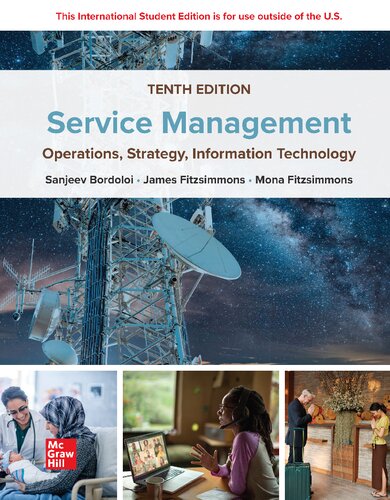(EBook PDF) Service Management Operations Strategy Information Technology 10th Edition by Sanjeev Bordoloi 1265075530 978-1265075538 full chapter
$50.00 Original price was: $50.00.$25.00Current price is: $25.00.
Service Management: Operations, Strategy, Information Technology 10th Edition by Sanjeev K. Bordoloi – Ebook PDF Instant Download/DeliveryISBN: 1265075530, 978-1265075538
Full dowload Service Management: Operations, Strategy, Information Technology 10th Edition after payment.

Product details:
ISBN-10 : 1265075530
ISBN-13 : 978-1265075538
Author: Sanjeev K. Bordoloi
Bordoloi’s Service Management 10e contains extensive coverage of the impacts of COVID-19 including the service innovation and progress experienced by a global pandemic. Written in an engaging literary style, based on research and consulting experience of authors, it focuses on service for competitive advantage and integrates technology, operations, and human behavior and the need for continuous quality improvement to be effective in a global environment. This edition continues to acknowledge and emphasize the essential uniqueness of service management.
Service Management: Operations, Strategy, Information Technology 10th Table of contents:
PART ONE UNDERSTANDING SERVICES
Chapter 1 The Service Economy
Learning Objectives
Chapter Preview
Service Definitions
Facilitating Role of Services in an Economy
Economic Evolution
Stages of Economic Development
Preindustrial Society
Industrial Society
Postindustrial Society
Nature of the Service Sector
The Experience Economy
Consumer Service Experience
Business Service Experience
Service-Dominant Logic
Distinctive Characteristics of Service Operations
Customer Participation
Simultaneity
Perishability
Intangibility
Heterogeneity
Nontransferrable Ownership
The Service Package
Grouping Services by Delivery Process
Open-Systems View of Service Operations Management
Service Benchmark: Sharing-Economy Pioneers Uber and Airbnb
Summary
Key Terms and Definitions
Topics for Discussion
Interactive Exercise
CASE 1.1: Village Volvo
CASE 1.2: Xpresso Lube
Selected Bibliography
Endnotes
Chapter 2 Service Strategy
Learning Objectives
Chapter Preview
The Strategic Service Vision
Understanding the Competitive Environment of Services
Competitive Service Strategies
Overall Cost Leadership
Differentiation
Focus
Strategic Analysis
Porter’s Five Forces Analysis
SWOT Analysis: Strengths, Weaknesses, Opportunities, Threats
Winning Customers in the Marketplace
Competitive Role of Information in Services
Creation of Barriers to Entry
Revenue Generation
Database Asset
Productivity Enhancement
Using Information to Categorize Customers
The Virtual Value Chain
First Stage (New Processes)
Second Stage (New Knowledge)
Third Stage (New Products)
Fourth Stage (New Relationships)
Data Analytics in Services
Internet of Things (IoT)
Limits in the Use of Information
Invasion of Privacy
Data Security
Reliability
Anticompetitive
Fairness
Economics of Scalability
Sustainability in Services
Triple Bottom Line (TBL)
Socio-Economic Implications of COVID-19
Stages in Service Firm Competitiveness
Available for Service
Journeyman
Distinctive Competence Achieved
World-Class Service Delivery
Service Benchmark: Outside the Box
Summary
Key Terms and Definitions
Topics for Discussion
Interactive Exercise
CASE 2.1: United Commercial Bank and El Banco
CASE 2.2: The Alamo Drafthouse
Selected Bibliography
Endnotes
PART TWO DESIGNING THE SERVICE ENTERPRISE
Chapter 3 New Service Development
Learning Objectives
Chapter Preview
Sources of Service Sector Growth
Information Technology
The Internet as a Service Enabler
Innovation Drivers
Changing Demographics
Innovation in Services
Challenges of Adopting New Technology in Services
Readiness to Embrace New Technology
Blockchain’a Radical Innovation
New Service Development
Service Design Elements
Service Blueprinting
Strategic Positioning through Process Structure
Taxonomy for Service Process Design
Degree of Divergence
Object of the Service Process
Type of Customer Contact
Generic Approaches to Service System Design
Production-Line Approach
Customer as Coproducer
Customer Contact Approach
Information Empowerment
Intellectual Property
Service Benchmark: Ten Things Google Has Found to Be True
Summary
Key Terms and Definitions
Topics for Discussion
Interactive Exercise
CASE 3.1: 100 Yen Sushi House
CASE 3.2: Commuter Cleaning–A New Venture Proposal
CASE 3.3: Zoom Video Communications
Selected Bibliography
Endnotes
Chapter 4 The Service Encounter
Learning Objectives
Chapter Preview
Technology in the Service Encounter
The Emergence of Self-Service
The Service Encounter Triad
Encounter Dominated by the Service Organization
Contact Personnel–Dominated Encounter
Customer-Dominated Encounter
The Service Organization
Culture
Empowerment
Control Systems
Customer Relationship Management
Contact Personnel
Selection
Training
Creating an Ethical Climate
The Customer
Expectations and Attitudes
The Role of Scripts in Coproduction
Customer Behavior Changes Following COVID-19
Creating a Customer Service Orientation
Service Profit Chain
Service Benchmark: Miss Manners on Complaint Handling
Summary
Key Terms and Definitions
Topics for Discussion
Interactive Exercise
CASE 4.1: Amy’s Ice Cream
CASE 4.2: Enterprise Rent-A-Car
Selected Bibliography
Endnotes
Chapter 5 Supporting Facility and Process Flows
Learning Objectives
Chapter Preview
Environmental Psychology and Orientation
Servicescapes
Behaviors in Servicescapes
Environmental Dimensions of Servicescapes
Facility Design
Nature and Objectives of Service Organizations
Land Availability and Space Requirements
Flexibility
Security
Esthetic Factors
The Community and Environment
Process Analysis
Types of Processes
Flowcharting
Gantt Chart
Process Terminology
Facility Layout
Flow Process Layout and the Work Allocation Problem
Job Shop Process Layout and the Relative Location Problem
The Office Post COVID-19
Service Benchmark: Where, Oh Where Shall We Go?
Summary
Key Terms and Definitions
Topics for Discussion
Interactive Exercise
Solved Problems
Exercises
CASE 5.1: Health Maintenance Organization (A)
CASE 5.2: Health Maintenance Organization (B)
CASE 5.3: Esquire Department Store
CASE 5.4: Central Market
Selected Bibliography
Endnotes
Chapter 6 Service Quality
Learning Objectives
Chapter Preview
Defining Service Quality
Dimensions of Service Quality
Gaps in Service Quality
Measuring Service Quality
SERVQUAL
Walk-Through Audit
Quality Service by Design
Incorporation of Quality in the Service Package
Poka-Yoke (Failsafing)
Quality Function Deployment
Achieving Service Quality
Cost of Quality
Statistical Process Control
Unconditional Service Guarantee
Service Recovery
Approaches to Service Recovery
Complaint Handling Policy
Service Benchmark: Bronson Methodist Hospital
Summary
Key Terms and Definitions
Topics for Discussion
Interactive Exercise
Solved Problems
Exercises
CASE 6.1: Clean Sweep, Inc.
CASE 6.2: The Complaint Letter
CASE 6.3: The Helsinki Museum of Art and Design
Selected Bibliography
Endnotes
Chapter 7 Process Improvement
Learning Objectives
Chapter Preview
Quality and Productivity Improvement Process
Foundations of Continuous Improvement
Plan-Do-Check-Act (PDCA) Cycle
Problem Solving
Quality Tools for Analysis and Problem Solving
Check Sheet
Run Chart
Histogram
Pareto Chart
Flowchart
Cause-and-Effect Diagram
Scatter Diagram
Control Chart
Benchmarking
Improvement Programs
Deming’s 14-Point Program
ISO 900
187 Six Sigma
Lean Service
Rethinking Lean Service after COVID-19
Service Benchmark: When Something Doesn’t Work–Sometimes Just Hit It with a Hammer!
Summary
Key Terms and Definitions
Topics for Discussion
Interactive Exercise
CASE 7.1: Sonora County Sheriff
CASE 7.2: Mega Bytes Restaurant
Chapter 7 Supplement: Data Envelopment Analysis (DEA)
Measuring Service Productivity
The DEA Model
DEA and Strategic Planning
Exercises
CASE 7.3: Mid-Atlantic Bus Lines
Selected Bibliography
Endnotes
Chapter 8 Service Facility Location
Learning Objectives
Chapter Preview
Strategic Location Considerations
Competitive Clustering
Saturation Marketing
Marketing Intermediaries
Substitution of Communication for Travel
Separation of Front from Back Office
Impact of the Internet on Service Location
Site Considerations
Geographic Information Systems
Facility Location Modeling Considerations
Geographic Representation
Number of Facilities
Optimization Criteria
Facility Location Techniques
Cross-Median Approach for a Single Facility
Huff Model for a Retail Outlet
Location Set Covering for Multiple Facilities
Regression Analysis in Location Decisions
Service Benchmark: Here a Bun, There a Bun, Everywhere a Bun-Bun
Summary
Key Terms and Definitions
Topics for Discussion
Interactive Exercise
Solved Problems
Exercises
CASE 8.1: Health Maintenance Organization (C)
CASE 8.2: Athol Furniture, Inc.
Selected Bibliography
Endnotes
PART THREE MANAGING SERVICE OPERATIONS
Chapter 9 Service Supply Relationships
Learning Objectives
Chapter Preview
Supply Chain Management
Network Model
Managing Uncertainty
Omnichannel Supply Chain
Impact of COVID-19 on Supply Chain Design
Service Supply Relationships
Customer–Supplier Duality
Service Supply Relationships Are Hubs, Not Chains
Managing Service Relationships
Bidirectional Optimization
Productive Capacity
Perishability
Social Media in Services
Social Media as a Competitive Strategy
Social Media and Customer Convenience
Social Media for Organizing and Co-Creation of Value
Professional Service Firms
Attributes of Professional Services
Service Consulting
Operational Characteristics
Outsourcing Services
Benefits and Risks of Outsourcing Services
Classification of Business Services
Managerial Considerations with Service Outsourcing
Service Benchmark: Citizens Come First in Lynchburg
Summary
Key Terms and Definitions
Topics for Discussion
Interactive Exercise
CASE 9.1: Boomer Consulting, Inc.
CASE 9.2: Evolution of B2C E-Commerce in Japan
Selected Bibliography
Endnotes
Chapter 10 Globalization of Services
Learning Objectives
Chapter Preview
Domestic Growth and Expansion Strategies
Focused Service
Focused Network
Clustered Service
Diversified Network
Franchising
The Nature of Franchising
Benefits to the Franchisee
Issues for the Franchiser
Globalization of Services
The Nature of a Borderless World
Generic International Strategies
Global Service Strategies
Multicountry Expansion
Importing Customers
Following Your Customers
Service Offshoring
Beating the Clock
Planning Transnational Operations
Service Benchmark: Small World and Other Myths
Summary
Key Terms and Definitions
Topics for Discussion
Interactive Exercise
CASE 10.1: Goodwill Industries of Central Texas
CASE 10.2: FedEx: Tiger International Acquisition
Selected Bibliography
Endnotes
Chapter 11 Managing Capacity and Demand
Learning Objectives
Chapter Preview
Generic Strategies of Level Capacity or Chase Demand
Strategies for Managing Demand
Customer-Induced Variability
Segmenting Demand
Offering Price Incentives
Promoting Off-Peak Demand
Developing Complementary Services
Reservation Systems and Overbooking
Strategies for Managing Capacity
Defining Service Capacity
Daily Workshift Scheduling
Weekly Workshift Scheduling with Days-Off Constraint
Increasing Customer Participation
Creating Adjustable Capacity
Sharing Capacity
Cross-Training Employees
Using Part-Time Employees
Yield Management
Yield Management Applications
Service Benchmark: Pay Up Front and Take Your Chances
Summary
Key Terms and Definitions
Topics for Discussion
Interactive Exercise
Solved Problems
Exercises
CASE 11.1: River City National Bank
CASE 11.2: Gateway International Airport
CASE 11.3: The Yield Management Analyst
CASE 11.4: Sequoia Airlines
Selected Bibliography
Endnotes
Chapter 12 Managing Waiting Lines
Learning Objectives
Chapter Preview
The Economics of Waiting
Queuing Systems
Strategies for Managing Customer Waiting
The Psychology of Waiting
That Old Empty Feeling
A Foot in the Door
The Light at the End of the Tunnel
Excuse Me, but I Was Next
Essential Features of Queuing Systems
Calling Population
Arrival Process
Queue Configuration
Queue Discipline
Service Process
Service Benchmark: The Magic of Disney Makes Queues Disappear
Summary
Key Terms and Definitions
Topics for Discussion
Interactive Exercise
Solved Problem
Exercises
CASE 12.1: Thrifty Car Rental
CASE 12.2: Eye’ll Be Seeing You
CASE 12.3: Field Study
Selected Bibliography
Endnotes
Chapter 13 Capacity Planning and Queuing Models
Learning Objectives
Chapter Preview
Capacity Planning
Strategic Role of Capacity Decisions
Analytical Queuing Models
Relationships Among System Characteristics
Standard M/M/1 Model
Standard M/M/c Model
M/G/1 Model
General Self-Service M/G/∞ Model
Finite-Queue M/M/1 Model
Finite-Queue M/M/c Model
Capacity Planning Criteria
Average Customer Waiting Time
Probability of Excessive Waiting
Minimizing the Sum of Customer Waiting Costs and Service Costs
Probability of Sales Lost Because of Inadequate Waiting Area
Service Benchmark: Don’t Guesstimate, Simulate!
Summary
Key Terms and Definitions
Topics for Discussion
Interactive Exercise
Solved Problems
Exercises
CASE 13.1: Houston Port Authority
CASE 13.2: Freedom Express
CASE 13.3: Renaissance Clinic (A)
Chapter 13 Supplement: Computer Simulation
Systems Simulation
Simulation Methodology
Monte Carlo Simulation
Generating Random Variables
Discrete-Event Simulation
Process Simulator by ProModel
Automobile Driver’s License Office Revisited
Solved Problems
Exercises
CASE 13.4: Drivers License Renewal
CASE 13.5: Renaissance Clinic (B)
Selected Bibliography
Endnotes
PART FOUR Quantitative Models for Service Management
Chapter 14 Forecasting Demand for Services
Learning Objectives
Chapter Preview
The Choice of Forecasting Method
Subjective Models
Delphi Method
Cross-Impact Analysis
Historical Analogy
Causal Models
Regression Models
Econometric Models
Time Series Models
N-Period Moving Average
Simple Exponential Smoothing
Forecast Error
Relationship Between α and N
Exponential Smoothing with Trend Adjustment
Exponential Smoothing with Seasonal Adjustment
Exponential Smoothing with Trend and Seasonal Adjustments
Summary of Exponential Smoothing
Service Benchmark: Googling the Future
Summary
Key Terms and Definitions
Topics for Discussion
Interactive Exercise
Solved Problems
Exercises
CASE 14.1: Oak Hollow Medical Evaluation Center
CASE 14.2: Gnomial Functions, Inc.
Selected Bibliography
Endnotes
Chapter 15 Managing Service Inventory
Learning Objectives
Chapter Preview
Inventory Theory
Role of Inventory in Services
Characteristics of Inventory Systems
Relevant Costs of an Inventory System
Order Quantity Models
Economic Order Quantity
Inventory Model with Quantity Discounts
Inventory Model with Planned Shortages
Inventory Management Under Uncertainty
Inventory Control Systems
Continuous Review System
Periodic Review System
The ABCs of Inventory Control
Radio Frequency Identification
Single-Period Model for Perishable Goods
Expected Value Analysis
Marginal Analysis
Retail Discounting Model
Service Benchmark: Your Bag Is Tagged
Summary
Key Terms and Definitions
Topics for Discussion
Interactive Exercise
Solved Problems
Exercises
CASE 15.1: A.D. Small Consulting
CASE 15.2: Last Resort Restaurant
CASE 15.3: Elysian Cycles
Selected Bibliography
Endnotes
Chapter 16 Managing Service Projects
Learning Objectives
Chapter Preview
The Nature of Project Management
Characteristics of Projects
Project Management Process
Selecting the Project Manager
Building the Project Team
Principles of Effective Project Management
Techniques for Project Management
Gantt Project Charts
A Critique of Gantt Charts
Constructing a Project Network
Critical Path Method
Microsoft Project Analysis
Resource Constraints
Activity Crashing
Incorporating Uncertainty in Activity Times
Estimating Activity Duration Distributions
Project Completion Time Distribution
A Critique of the Project Completion Time Analysis
Problems with Implementing Critical Path Analysis
Monitoring Projects
Earned Value Chart
Project Termination
Project History Report
Service Benchmark: The House That Warren Built
Summary
Key Terms and Definitions
Topics for Discussion
Interactive Exercise
Solved Problems
People also search for Service Management: Operations, Strategy, Information Technology 10th:
product service management
jira service management pricing
field service management
food service management
customer service management
You may also like…
Business & Economics - Management & Leadership
Computers - Computer Business & Culture
Computers - Computer Business & Culture
Business & Economics - Management & Leadership
Human Resource Management: Strategy and Practice 10th Edition Nankervis
Computers - Information Systems
Information Technology Project Management 9th Edition Schwalbe
Business & Economics - Others
Uncategorized
Management












